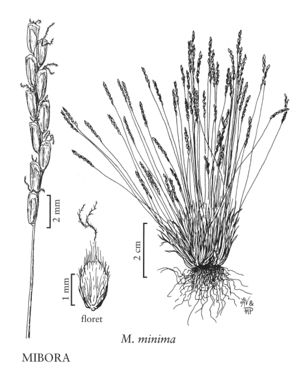Difference between revisions of "Mibora minima"
imported>Volume Importer |
imported>Volume Importer |
||
| Line 48: | Line 48: | ||
|publication year= | |publication year= | ||
|special status=Introduced | |special status=Introduced | ||
| − | |source xml=https://bitbucket.org/aafc-mbb/fna-data-curation/src/ | + | |source xml=https://bitbucket.org/aafc-mbb/fna-data-curation/src/200273ad09963decb8fc72550212de541d86569d/coarse_grained_fna_xml/V24/V24_1073.xml |
|subfamily=Poaceae subfam. Pooideae | |subfamily=Poaceae subfam. Pooideae | ||
|tribe=Poaceae tribe Poeae | |tribe=Poaceae tribe Poeae | ||
Latest revision as of 16:21, 11 May 2021
Plants tufted. Culms 2-10(15) cm; nodes 2-3, glabrous. Sheaths delicate, rounded on the back, shallowly grooved; ligules 0.2-1 mm; blades 1-4(5) cm long, to 0.5 mm wide, flat or involute, obtuse. Racemes 0.5-2(5) cm long, 1-2 mm wide, usually purplish; pedicels 0.5-1 mm. Spikelets 1.8-3 mm. Glumes 1.8-3 mm, obtuse to slightly emarginate; lemmas 1.4-2 mm, 5-veined, often denticulate at the apices; paleas 1.4-2 mm, narrowly elliptic, apices notched; anthers 1-1.7 mm. Caryopses 1-1.4 mm. 2n = 14.
Discussion
Mibora minima is native to western Europe, where it grows on sandy and other light, damp soils in places with mild winters. In central Europe, it usually flowers from February to April or May but, if the weather is warm, may flower in December.
Mibora minima was collected from ballast dumps in Plymouth, Massachusetts, in the first part of the twentieth century, and from an experimental farm in Sydney, British Columbia, in 1914. It has also been collected in Monroe County, New York. None of these populations appear to have led to the establishment of the species in North America. Recently, garden societies in both Canada and the United States have been offering the seed, recommending M. minima for rock gardens.
Selected References
None.
